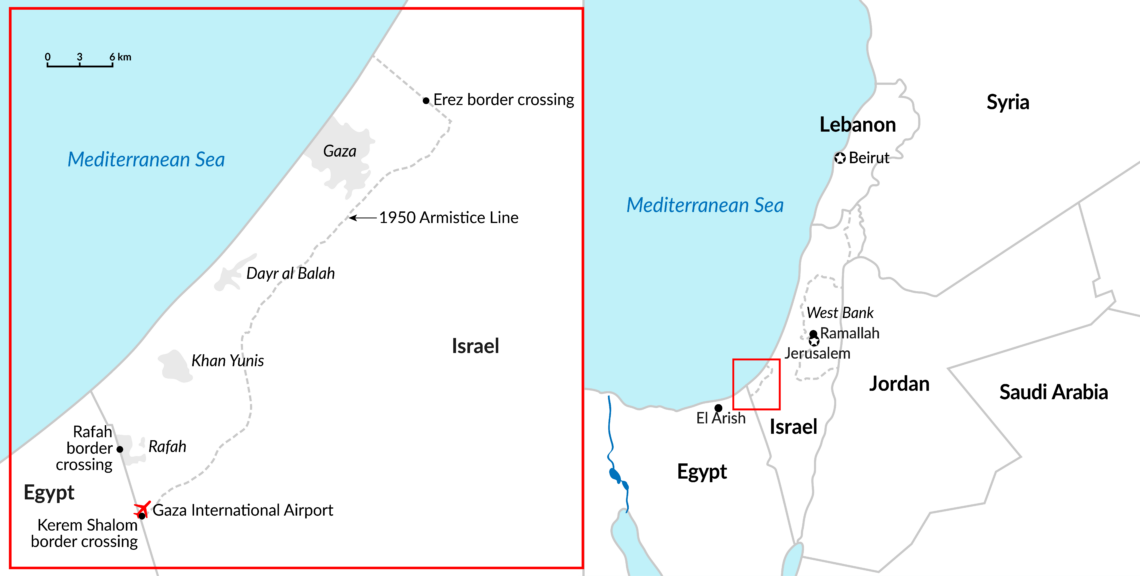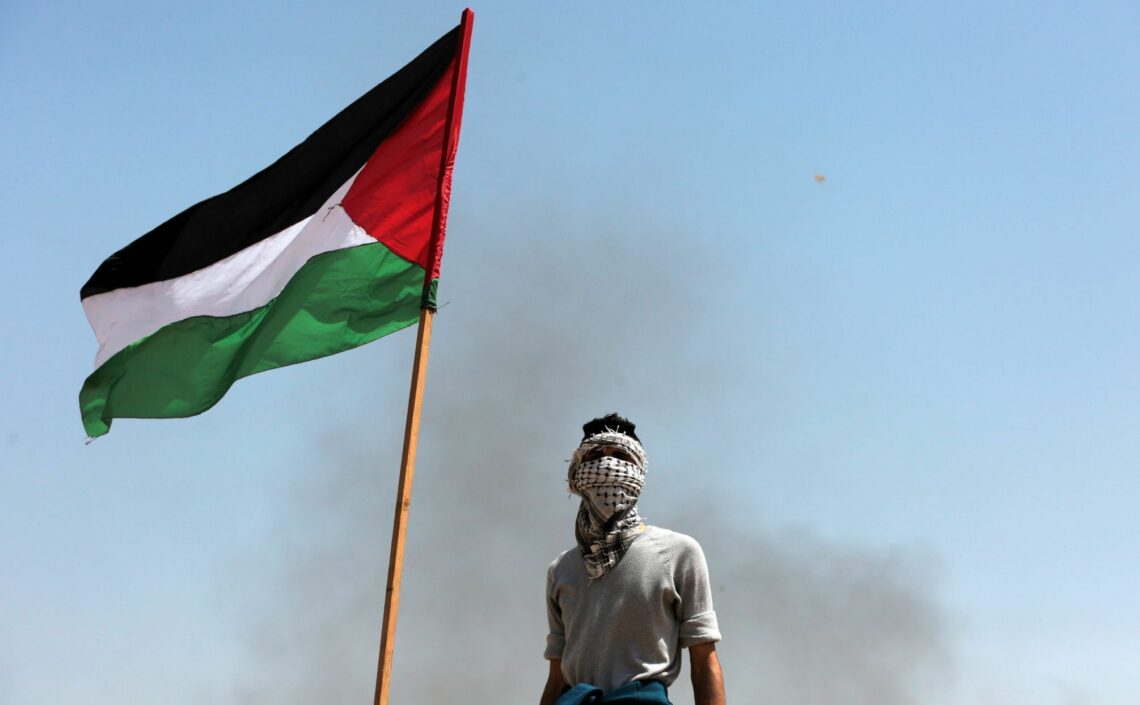Gaza and the Hamas problem
Cut off by their neighbors, the people of the Hamas-governed Gaza Strip suffer from high unemployment, low investment, and only sporadic electricity. With Hamas having proven itself dangerous, it is not difficult to see why the sanctions continue. Gaza’s fate remains sealed by the terrorist organization’s determination to destroy Israel.

In a nutshell
- Hamas has totally mismanaged governance of the Gaza Strip
- Its insistence on attacking Israel has only isolated the tiny exclave
- Negotiations continue, but are unlikely to bring any sustainable change
In 2007, Hamas, an offshoot of the Muslim Brotherhood, wrested control of the Gaza Strip from the Fatah-led Palestinian National Authority in a bloody military coup. Ever since, the small tract of land has become a flash point for neighboring countries, especially Israel. The organization’s oft-repeated objective is the destruction of the Jewish state, and it frequently conducts attacks to further that aim.
Israel is blockading the Strip as a protective measure, but the blockade is not total: hundreds of trucks carrying staples transit daily through the Kerem Shalom border crossing while people and cars pass through the checkpoint at Erez. Egypt, embroiled in a lengthy battle with the Sinai branch of the Islamic State (also known as Daesh or ISIS), needs quiet on its border with Gaza, on which it has also imposed a blockade. Cairo would like the Palestinian Authority to resume control and prevent Hamas contacts with the Muslim Brotherhood and ISIS.
Palestinian Authority President Mahmoud Abbas (also known as Abu Mazen) is doing his utmost to isolate and weaken Hamas in hopes of forcing the organization to restore his authority in Gaza. Qatar, a strong supporter of the Muslim Brotherhood and of Hamas, is trying to help the civilian population by providing millions of dollars in humanitarian assistance. The United Nations’ special envoy to the peace process in the Middle East, Nickolay Mladenov, has worked tirelessly to achieve some understanding between all parties.
Desperate situation
Violent demonstrations and attempts to breach the fortified fence marking Israel’s border are not a new phenomenon. However, they reached new heights this past April with the launch of the (ostensibly peaceful) “Great March of Return” protests, demanding that millions of Palestinians be allowed to enter Israel and that the blockade be lifted.
Hamas devotes millions of dollars intended for humanitarian relief to building up its military.
The new policy was born of Hamas’ desperate straits after 11 years of fruitless military conflict with Israel, a situation compounded by the drastic economic sanctions imposed by President Abbas. Not only did he refuse to pay the salaries of Hamas civil servants, but he also stopped payment for the fuel needed by the Gaza power plant to provide electricity.
Meanwhile, Hamas devotes its considerable resources and millions of dollars intended for humanitarian relief to building up its military. Cement badly needed to repair houses and build infrastructure is sunk into tunnels intended to bring terrorists into Israel. Flare-ups at the border are staged to garner international sympathy and pressure the Palestinian Authority into rescinding its sanctions and taking over the day-to-day administration of Gaza, while leaving Hamas free to continue the fight against Israel.
Gaza is a small strip of land along the Mediterranean Sea. It measures 6 to 12 kilometers wide and 41 kilometers long – 365 square kilometers altogether. It has borders of 11 km with Egypt and 51 km with Israel. It has a population of about 2 million.
In accordance with the Oslo agreements, Israel, which had taken over Gaza during the Six-Day War of 1967, handed it over to the Palestinian Authority while retaining security supervision. In 2005, it completely withdrew from the Strip and evacuated all Israelis living there, leaving behind Israeli-built industrial and agricultural infrastructure that should have been the basis of a thriving economy. Those ambitions were crushed in 2007, after Hamas drove out the Palestinian Authority in a brutal military coup that left dozens of Fatah militants dead and hundreds wounded.
History of violence
Hamas – which in Arabic is an acronym for the Islamic Resistance Movement – is a radical jihadist terror group established in 1987 by Sheikh Ahmed Yassin and other members of the Gaza branch of the Muslim Brotherhood. Its charter is unambiguous:
The Islamic Resistance Movement is a distinct Palestinian movement which owes its loyalty to Allah, derives from Islam its way of life and strives to raise the banner of Allah over every inch of Palestine. … We must imprint on the minds of generations of Muslims that the Palestinian problem is a religious one, to be dealt with on this premise. … Israel, by virtue of its being Jewish and of having a Jewish population, defies Islam and the Muslims.
The Hamas takeover frightened investors away, while militants destroyed vital infrastructure left behind by Israel. The new leaders declared they would not abide by deals made between the Palestinian Authority and Israel, and established paramilitary forces to impose order domestically while developing the Izzadine al-Qassam Brigades to fight Israel. Rockets and mortar shells rained down on towns and villages across the border, while commandos tried to infiltrate into Israel. To prevent the smuggling of weapons into Gaza, Israel set up a land and maritime blockade.

Egypt had also set up a blockade and severely curtailed passage via the Rafah border crossing. It imposed further restrictions following a January 2008 incident in which Hamas militants blew up the border fence and thousands of Palestinians crossed into the Sinai Peninsula. Cairo destroyed most of the underground tunnels through which weapons and goods were smuggled into Gaza and established a five-kilometer buffer zone.
Intense rocket and missile fire into Israel has already led to three major military operations: “Cast Lead” in 2008-2009, “Pillar of Defense” in 2012 and “Protective Edge” in 2014. Despite extensive destruction and loss of life in Gaza, Hamas has not been deterred from its goal of destroying the Jewish state. Neglecting the suffering of its population from high unemployment and insufficient welfare infrastructure, it is investing funds provided by Iran and pro-Islamic European organizations (under the guise of humanitarian aid) to develop sophisticated missiles and tunnels, and has now established a naval unit to attack civilian towns from the sea.
Israel has so far found answers to all these threats. Its “Iron Dome” system stops Hamas missiles and a reinforced underground concrete wall is stopping the tunnels. A similar wall is being partially built under the sea to stop penetration from that direction.
No progress
Egypt is trying to mediate not only between Hamas and Israel but also between Hamas and the Palestinian government in Ramallah. In 2011, Cairo got Fatah and Hamas to agree to a deal that was never implemented but still forms the basis of ongoing negotiations. Currently on the table is a three-step peace plan: a cease-fire, the reconstruction of Gaza and restoring Ramallah’s rule over the Strip.
The main stumbling blocks remain: Hamas will not put its military forces under the command of Ramallah.
However, the main stumbling blocks remain: Hamas will not put its military forces under the command of Ramallah and it will not stop fighting Israel. Egypt has not given up. Its emissaries keep bustling between Cairo, Gaza, Ramallah and Israel – so far with to no effect.
Meanwhile, the violent demonstrations continue. Explosive devices are hurled at the fence every day. Armed militants attempt to cross into Israel. Hamas has also found a new and effective technique: sending incendiary kites and balloons across the border. Large tracts of land and nature reserves have been destroyed by fire. Sporadic rocket fire sends civilians rushing to the nearest shelter.
The international community refrains from condemning these acts of aggression and tends to focus on the loss of life in Gaza when Israeli soldiers shoot to drive militants away. Israeli leaders have repeated that if the border is made peaceful, they would be ready to take appropriate measures to alleviate the suffering of Gaza’s population, with a view to achieving some form of long-term coexistence.
Egypt, Qatar and the U.N representative still hope to achieve at least a temporary solution. In Israel, some cabinet ministers are calling for a comprehensive economic plan for the Gaza Strip, including building an artificial island off the coast that would host an airport and a maritime port (under Israeli security supervision to prevent weapons smuggling). A proposal to build a Gaza seaport in Cyprus was vetoed by Ramallah. Cairo rejected a suggestion to establish a port could be set up at El Arish.
The Palestinian Authority cannot accept the emergence of an independent state in Gaza.
The Egyptian government is still pressuring President Abbas to show some flexibility and cancel the sanctions on Gaza, but the old leader will not budge. Furthermore, the Palestinian Authority is vehemently opposed to any negotiation, however indirect, between Hamas and Israel, leading to some interim agreement, on the grounds that it would give Gaza quasi-state status while it should be under the Palestinian Authority’s sovereignty.
Scenarios
Nevertheless, there are new developments in the wings. A tentative agreement has allegedly been reached through mediating countries: Qatar will provide Hamas with some $90 million to cover six months’ salary for its civil servants and enough fuel for the power plant to deliver 12 to 16 hours of electricity a day (against four to six at present). Israel signaled that it was ready to go along and on November 8, a Qatari representative crossed from Israel into Gaza carrying $15 million in cash. The following day, thousands of demonstrators still came to the border fence, and there were several attempts to breach it.
Then the unexpected happened. Israeli undercover operatives in Gaza were discovered. One Israeli and seven Hamas militants were killed. This led to an intense bout of fighting, with Hamas firing more than 500 missiles at civilian targets across the border. Israeli planes retaliated, destroying 150 Hamas military targets (while being careful to avoid casualties). Such extensive damage was done that Hamas asked Egypt to broker a cease-fire. So far it is holding. Qatar has pledged to continue paying for salaries and fuel – for now.
What next? Hamas is so wholly committed to destroying Israel and “liberating” all of Palestine as the first step toward an Islamic caliphate that it is hard to see how it could relent. Letting Ramallah take over its military wing would be tantamount to giving up this goal, so that appears unlikely. The Palestinian Authority cannot accept the emergence of an independent state in Gaza and will not agree to anything less than total surrender from Hamas. The senseless conflict will continue, perhaps with less intensity, unless the unthinkable happens and the population of Gaza turns against the rulers who have for so long caused them such hardship.








